South African Commando System
| SADF Commando System | |
|---|---|
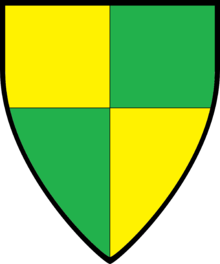 | |
| Country |
|
| Allegiance |
|
| Branch |
|
| Type | Area protection/Militia |
| Insignia | |
| SADF Commando Beret Badge |
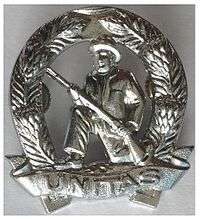 |
| SADF Commando Beret bar |
 |
| SADF Commando Shooting Competancy |
 |
| SADF Commando Stable Belt |
 |
| SADF Commando Unit Company level flash |
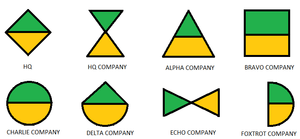 |
The South African Commando System was a mostly voluntary, part-time force of the South African Army,[1][2] but in their role as local militia the unit was often under the authority of the South African Police.
Mission
South Africa's Commando System was responsible for the safeguarding and protection of specific communities (usually rural, but sometimes urban). Commando units were usually referred to as area protection, a system which involved the whole community. The participants in the Commando System did not have military commitments outside of the areas they served and were responsible for the safety and security of their own communities.
History
Origin
The Commando system existed from the 1770s. The early Boer Commando system was a conscriptive service designed to provide a quickly-trained fighting force.
Commandos were a product of the First Boer War[3] during which the fiercely independent Boers had no regular army. When danger threatened, all the men in a district would form a militia organised into military units called commandos and would elect officers. Being civilian militia, each man wore what they wished, usually everyday neutral or earthtone khaki farming clothes such as a jacket, trousers and slouch hat. Each man brought his own weapon, usually a hunting rifle, and his own horses. The average Boer citizens who made up their commandos were farmers who had spent almost all their working life in the saddle, and because they had to depend on both their horse and their rifle for almost all of their meat, they were skilled hunters and expert marksmen. Most of the Boers had single-shot breech-loading rifles such as the Westley Richards, the Martini-Henry, or the Remington Rolling Block. Only a few had repeaters like the Winchester or the Swiss Vetterli. As hunters they had learned to fire from cover, from a prone position and to make the first shot count, knowing that if they missed the game would be long gone. At community gatherings, target shooting was a major sport and competitions used targets such as hens eggs perched on posts 100 yards away. The commandos became expert light cavalry, making use of every scrap of cover, from which they could pour an accurate and destructive fire at the British with their breech-loading rifles which could be rapidly aimed, fired, and reloaded.
At least during the Second Boer War each commando was attached to a town, after which it was named (e.g. Bloemfontein Commando). Each town was responsible for a district, divided into wards. The Commando was commanded by a Kommandant and each ward by a Veldkornet or fieldcornet - equavilent of a senior NCO rank. The Veldkornet was responsible not only for calling up the burghers, but also for policing his ward, collecting taxes, issuing firearms and other material in times of war. Theoretically, a ward was divided into corporalships. A corporalship was usually made up of about 20 burghers. Sometimes entire families filled a corporalship. The Veldkornet was responsible to the Kommandant, who in turn was responsible to a General. In theory, a General was responsible for four commandos. He in turn was Responsible to the Commander-in-Chief (CIC) of the Republic. In the Transvaal, the CIC was called the Commandant-General and in the Free State the Hoofdkommandant or Chief Commandant. The CIC was responsible to the President.
Other auxiliary ranks were created in war time, such as Vleiskorporaal ("meat corporal"), responsible for issuing rations.
Shooting Clubs
After the declaration of peace in 1902, the commandos were disbanded. Many former members formed themselves into shooting clubs.
Commando System Structure in the UDF, SADF and SANDF
In 1912, the commandos were reformed alongside the Active Citizen Force as part of the Union Defence Force. This system was in operation until in February 2003.
Cell organisation
Each community was divided up into smaller more manageable sections called cells. Each cell comprised a number of farmers and or households, depending on the size of the area and dispersion of the area’s inhabitants. Cell members were in contact with each other by means of telephone or a radio system (Marnet) which served as a backup communication system in the event of the telephone lines being out of order. Alternative communication systems was therefore a vital element of the protection plan of any cell. The cell members would have a communication link with their cell leader (who was elected by the members) who, in turn, had a communication link with the local police station. This ensured quick reaction by the police in the event of an attack. The cell leader could notify the local Commando if a stronger force was required.
This process of communication was time-consuming and, therefore, the members of a cell would be able to protect themselves and rely on support from neighbours and other members of the cell to ensure immediate response in an emergency. For this reason a cell would plan for certain contingencies before they happen. The local Commando would assist the cells with drawing up contingency plans.
"The farmer-commandos receive a few weekends of training as army reservists and are each given an assault rifle. When they respond to an incident, the police do, too. But the police force is stretched thin in farm areas, trying to cover vast areas with few officers or vehicles. The farmers often get there much sooner."[4]
The retirement age of members of the commandos was 65 although it could be extended to 75 years.[5]

Commando organisation
Community cells were administered under distinct local commando units.
Group organisation
Several local commandos units were administered as Group units.
Command organisation
Several Groups,usually in a provincial context resorted under a Provincial Command.
Commando Training
The Commando System had its own Commando Training School, where skills received from National Service was sharpened.

Weaponry
From the early days up until their disbandment, the commandos were issued with firearms by the government of the day. The burghers were obliged to keep these firearms serviceable and ready at all times.
Group Headquarters Organisation
Under the SADF
Under the SADF, Commando units were grouped regionally under Commands: (Please note: This was not a wholly static structure and units could move occaisionally between Groups, the diagrams below depict the structure from the late 1980's)
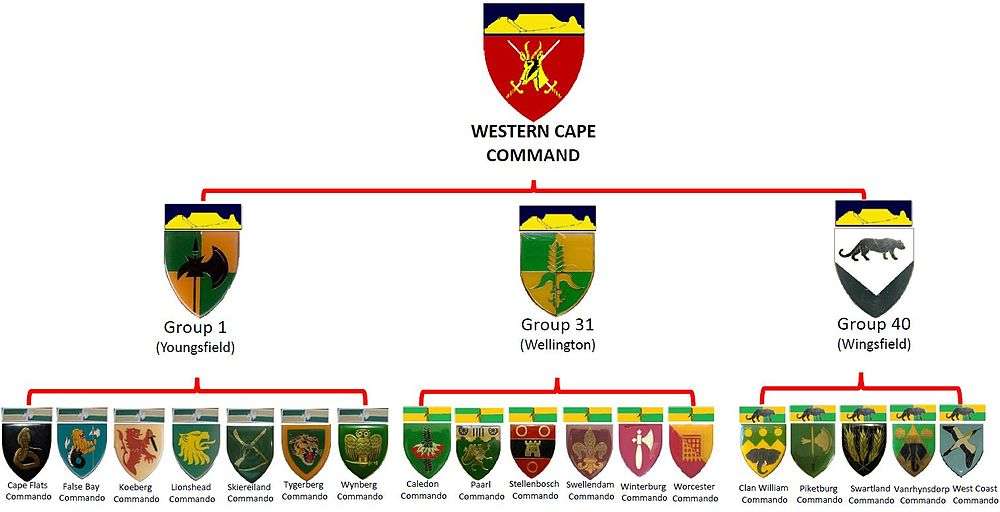
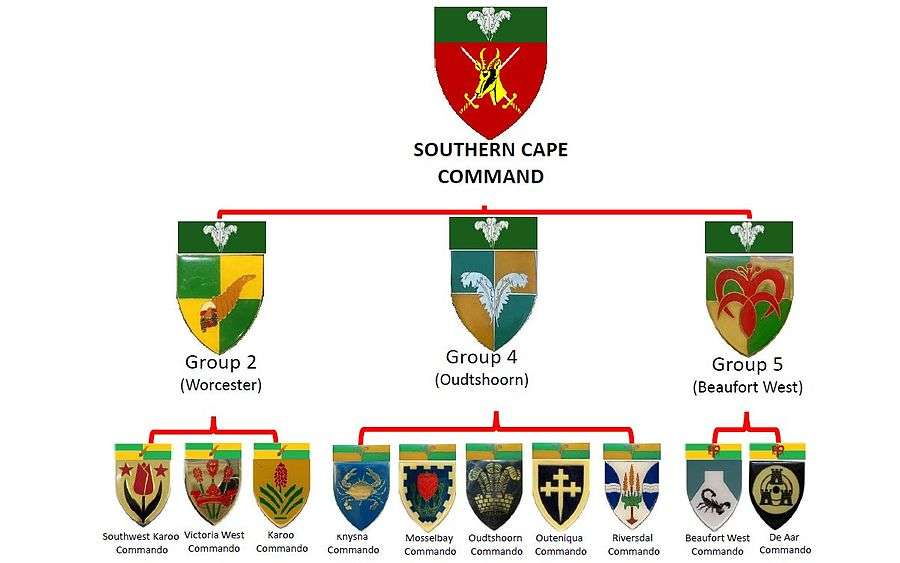
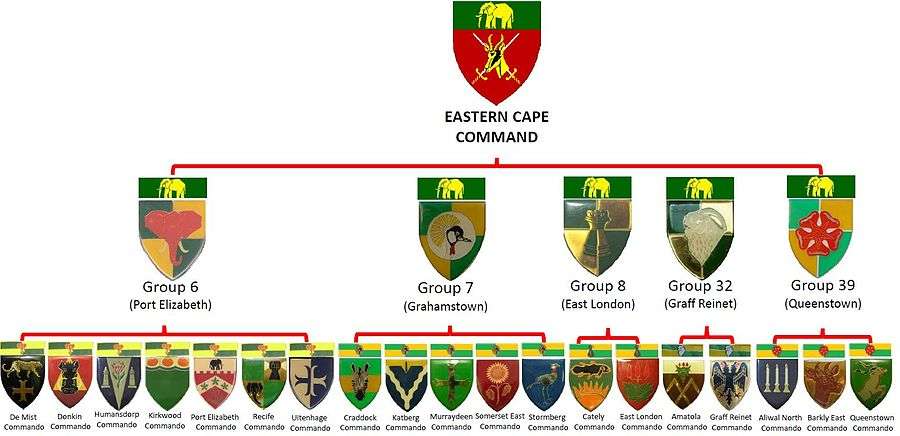
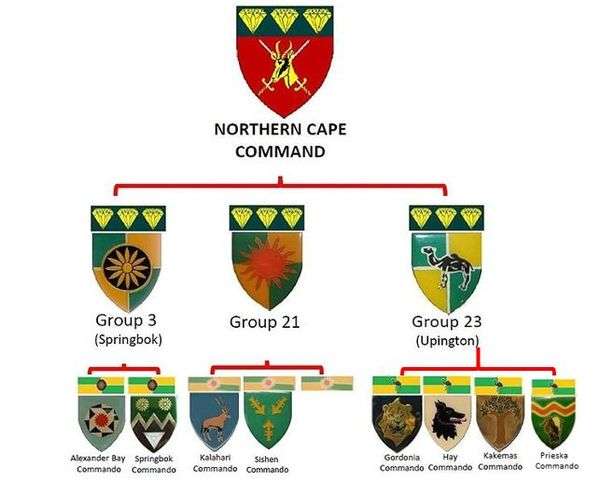
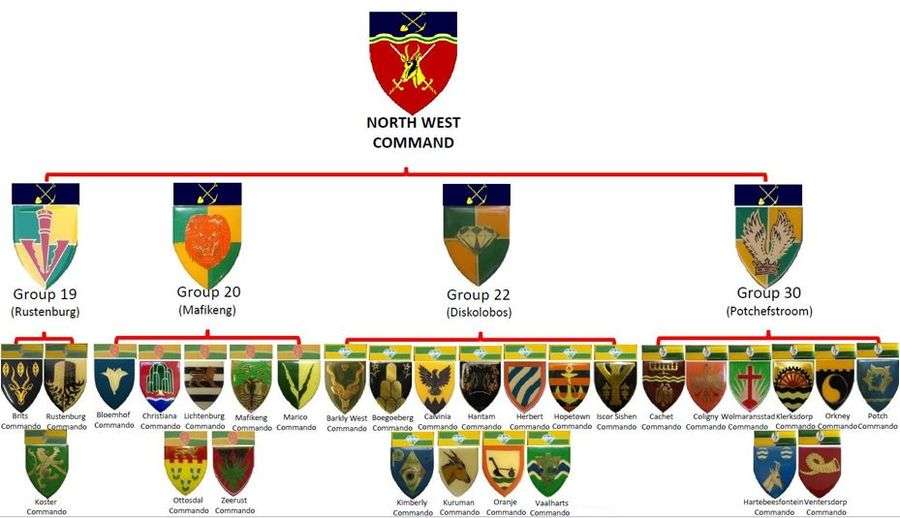
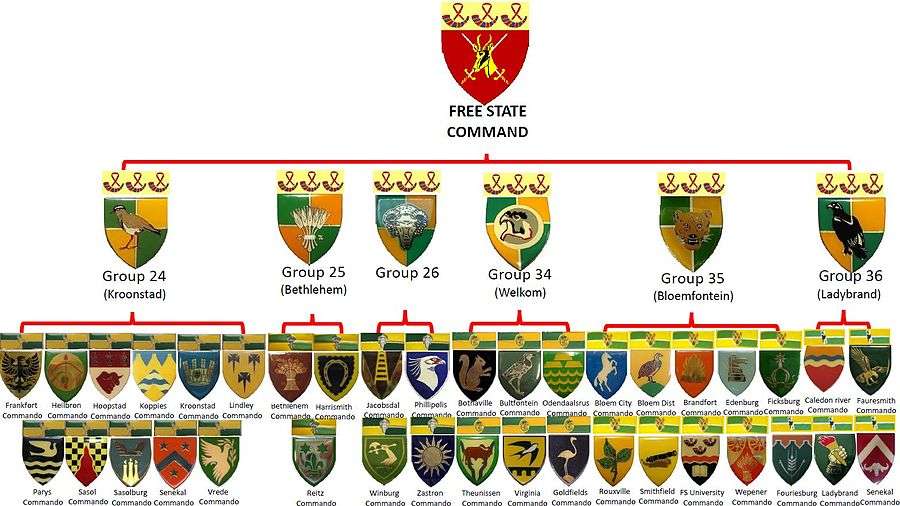

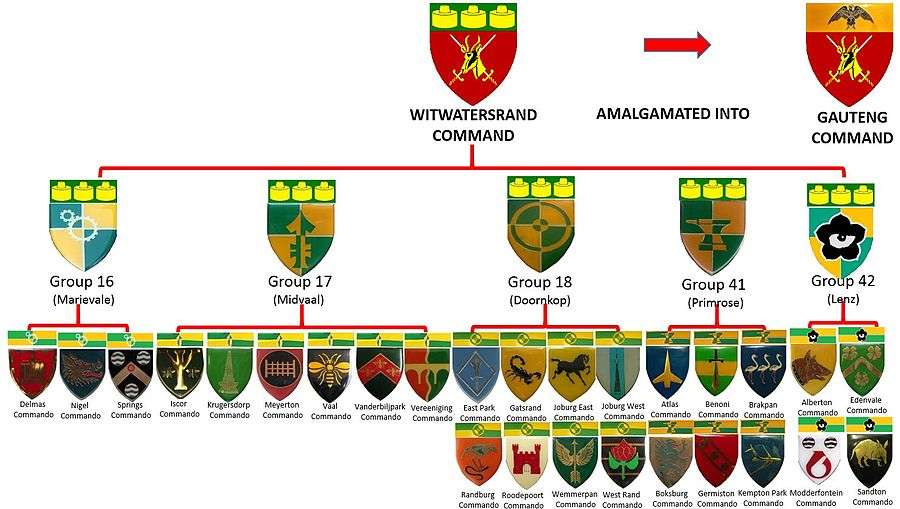
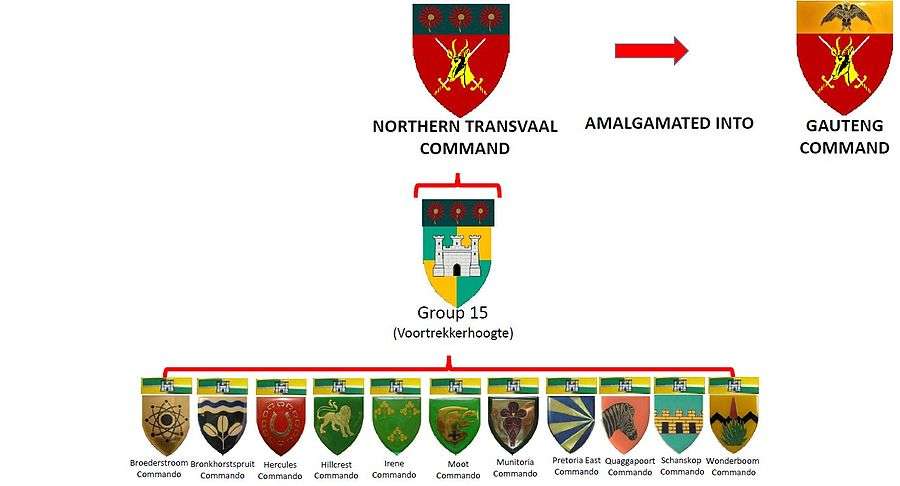
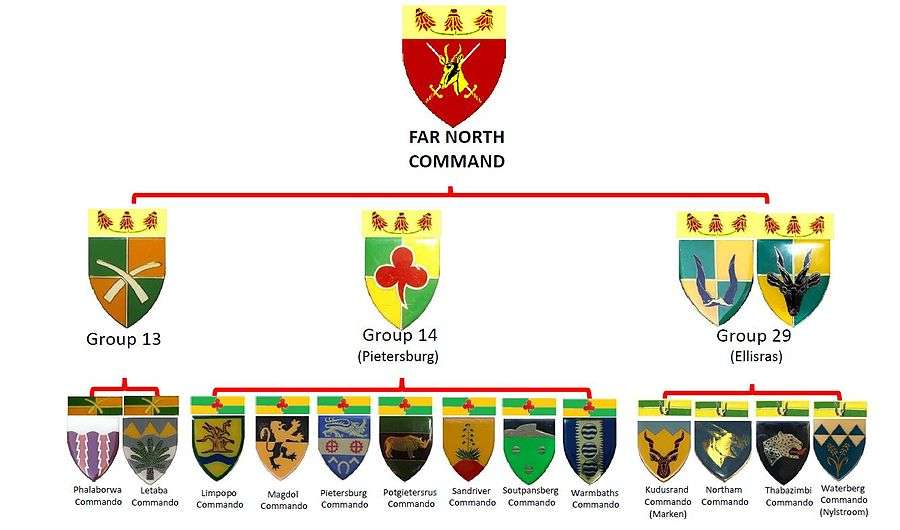
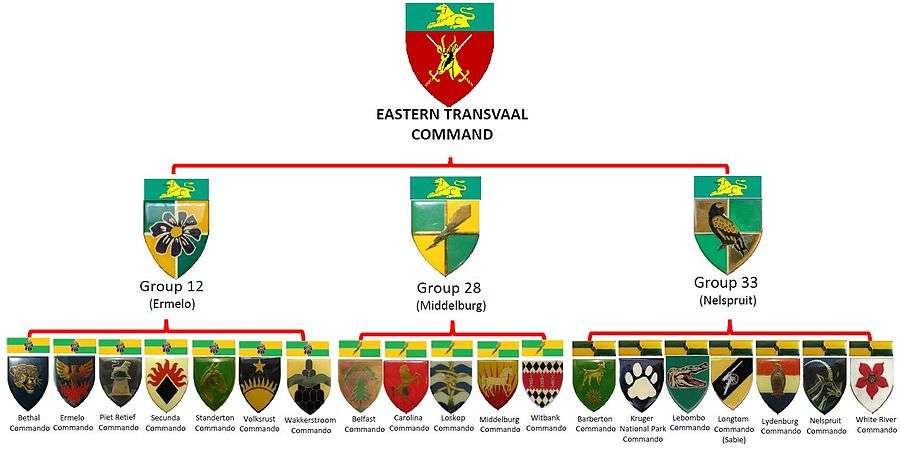
Under the SANDF
By 2005, after Army restructuring several groups became amalgamated under General Support Bases, GSBs. Group numbers therefore did not follow the original sequence.
- Group 1 HQ - Kelvin GSB Youngsfield SA Army Infantry Formation 10 x Commandos[6]
- Group 2 HQ - Oudtshoorn GSB Oudtshoorn SA Army Infantry Formation 8 x Commandos
- Group 3 HQ
- Group 4 HQ
- Group 5 HQ
- Group 6 HQ - Port Elizabeth GSB Port Elizabeth SA Army Infantry Formation 15 x Commandos
- Group 7 HQ
- Group 8 HQ East London
- Group 9 HQ - Pietermarizburg GSB Durban SA Army Infantry Formation 5 x Commandos
- Group 10 HQ - Montclair GSB Durban SA Army Infantry Formation 5 x Commandos
- Group 11 HQ
- Group 12 HQ - Ermelo GSB Nelspruit SA Army Infantry Formation 11 x Commandos
- Group 13 HQ
- Group 14 HQ - Pietersburg GSB Pietersburg SA Army Infantry Formation 7 x Commandos
- Group 15 HQ - Thaba Tshwane GSB Thaba Tshwane SA Army Infantry Formation 6 x Commandos
- Group 16 HQ - Marievale GSB Johannesburg SA Army Infantry Formation 8 x Commandos
- Group 17 HQ
- Group 18 HQ - Doornkop GSB Johannesburg SA Army Infantry Formation 11 x Commandos
- Group 20 HQ - Mnabatho GSB Potchefstroom SA Army Infantry Formation 9 x Commandos
- Group 21 HQ
- Group 22 HQ - Diskobolos GSB Kimberley SA Army Infantry Formation 10 x Commandos
- Group 23 HQ - Upington GSB Lohathla SA Army Infantry Formation 7 x Commandos
- Group 24 HQ - Kroonstad GSB Kroonstad SA Army Infantry Formation 17 x Commandos
- Group 25 HQ
- Group 26 HQ
- Group 27 HQ - Eshowe GSB Ladysmith SA Army Infantry Formation 5 x Commandos
- Group 28 HQ
- Group 29 HQ
- Group 30 HQ - Potchefstroom GSB Potchefstroom SA Army Infantry Formation 12 x Commandos
- Group 31 HQ
- Group 32 HQ
- Group 33 HQ - Nelspruit GSB Nelspruit SA Army Infantry Formation 8 x Commandos
- Group 34 HQ- Welkom SA Army Infantry Formation 4 x Commandos
- Group 35 HQ Bloemfontein
- Group 36 HQ - Tempe GSB Bloemfontein SA Army Infantry Formation 16 x Commandos
- Group 41 HQ
- Group 42 HQ
- Group 45 HQ
- Group 46 HQ - Umtata GSB Port Elizabeth SA Army Infantry Formation 7 x Commandos
Disbandment
President Mbeki announced the disbanding of the commando system over six years, to be replaced by 'specialised police units'. The Democratic Alliance has stated that this action is a 'total disaster'.[7]
Its spokesman, Armiston Watson said that "the disbanding of the rural commandos (announced by the government in 2003) was an irresponsible political move which now leaves all farmers and farm workers defenceless and easy targets for criminals."[8][9]
Agri SA Chairman Kiewiet Ferreira, a farmer in the central Free State Province town of Harrismith said: "We need commandos, and we see them as one of the backbones of the rural protection plan, without a doubt" He also pointed out that, in 1998, former President Nelson Mandela included the commandos in a rural security plan, and "encouraged farmers, especially white farmers, to join the commandos and help in rural protection". "If you [take into account] how many operations commandos have been involved in, under the police - more than 50,000 operations in 2001 and 37,000 operations in 2002 (most of them road-blockades, foot patrols, vehicle patrols, farm visits, manning of observation posts) - that's nearly 90,000 operations in two years," Ferreira said.[10]
There have been some acknowledgements by the current Army Command that the Commandos had a utility which is now lacking.[11]

The system was phased out between 2003 and 2008 “because of the role it played in the apartheid era”, according to the Minister of Safety and Security Charles Nqakula.[12] In 2005 then-Minister of Defence Mousioua Lekota explained that the process was "driven partly to counter racist elements within some of commandos, but also because of constitutional issues."[13] This followed growing pressure after incidents of ongoing abuse of power were reported.[14]
The last commando unit, Harrismith Commando based in the Free State, was disbanded in March 2008. At their peak 186 of these units, ranging in size from a company to a battalion, existed. The number of individual commando members varied according to different sources, but it is estimated that there were between 50,000 and 70,000.[15]
The effectiveness of the commandos varies from one area to the next. The commandos are tasked with assisting the police with rural safety and security. The commando is often made up of local farmers who may or may not be former members of the SANDF. They are issued with state weapons. These commandos are often the first to receive a call for assistance from the farmer under attack, since farms are generally far away from police stations. Many farmers in the rural areas are linked to each other via a [MARNET] radio system. The commandos then call the police and inform them that a crime has been committed. They set up a roadblock and start looking for the suspects. There are three types of commando structures in the rural areas:
- Area-bound reaction force commando members
- Home and Hearth protection reaction force commando members, and
- House and Hearth protection commando members.
Area-bound reaction force units are composed of people who live in towns and cities. When there is an emergency these members are called upon to assist, and are issued with a uniform and rifle for that purpose. The members of this unit are trained with police reservists to conduct patrols, roadblocks, follow-up operations, cordon and search operations, and farm visits. Home and Hearth protection reaction force commando members are made up of farmers, smallholders, and their labourers. Once an incident has been reported on a farm in the area this commando is called. They set up roadblocks and a search begins for the suspects. House and Hearth protection commando members are composed in the same manner as the Home and Hearth protection reaction force commandos. However, they only protect their own properties and are given a rifle if they do not have their own. In addition to relying on the commandos, a contingency plan has been drawn up in some areas, using members of the local community to assist the police. This also contributes to the high rate of successful farm investigations.
…
On 14 February 2003 President Mbeki announced that the commando system would be phased out and replaced with sector policing under the leadership of the SAPS. The reasoning behind this was that crime prevention was not the mandate of the SANDF, but the responsibility of the SAPS.1 The President’s announcement created a great deal of unhappiness amongst farmers who rely upon commandos for rural safety and security. On 5 August 2003 the minister of Safety and Security confirmed that the commandos would be phased out over six years, but that special police units would be established in the rural areas and that commando members could get involved in these.
…
Research undertaken by the Committee found that farm workers are secondary victims of farm attacks, and although they may escape harm, are most likely to suffer when farms are sold, downsized or liquidated. None of the commandos have integrated farm workers into their structures. However, farm workers have a stake in the apprehending of perpetrators and may well be willing to participate in rural safety and security structures. As such, they are a significant resource in terms of any rural safety plan and need to be recruited more actively in this regard.
Institute for Security Studies: Ploughing in Resources - The Investigation of Farm Attacks
See also
References
![]() This article incorporates public domain material from the Library of Congress Country Studies website http://lcweb2.loc.gov/frd/cs/.
This article incorporates public domain material from the Library of Congress Country Studies website http://lcweb2.loc.gov/frd/cs/.
- ↑ Col L B van Stade, Senior Staff Officer Rationalisation, SANDF (1997). "Rationalisation in the SANDF: The Next Challenge". Institute for Security Studies. Retrieved 2008-06-23.
- ↑ "About the Commando system". Retrieved 2008-01-17.
- ↑ Duxbury, Geo. R. David and Goliath: The First War of Independence, 1880-1881 (Johannesburg: SA National Museum of Military History, 1981).
- ↑ NY times
- ↑ rfdiv.mil.za
- ↑ http://saairforce.co.za/forum/viewtopic.php?f=3&t=1322
- ↑ Anthony Benadie (12 November 2007). "Rural Security Crisis: Commando's SAPS Reservist integration process a disaster!". Democratic Alliance. Retrieved 2007-11-29.
- ↑ News 24
- ↑ Twala, Chitja; Oelofse*, Marietjie. "Rural Safety and the Disbandment of the Commando Units in South Africa: A Challenge to Rural Communities and the African National Congress (ANC)?" (PDF). krepublishers.com. Kre Publishers. Retrieved 7 November 2014.
- ↑ IRIN news
- ↑ "SANDF Decline, Transformation, Integration, Equity and Morale: Department of Defence Overview". Parliamentary Monitoring Group. 13 Nov 2014. Retrieved 14 December 2014.
- ↑ de Lange, Deon. "South Africa: Commandos Were 'Hostile to New SA'". Cape Argus. Retrieved 7 November 2014. (subscription required (help)).
- ↑ Ancer, Jonathan. "Commandos threaten to turn to crime". iol.co.za. Independent Online. Retrieved 7 November 2014.
- ↑ samaYende, Sizwe. "South Africa: Land Committee Lobbies For Commandos To Be Disbanded". allafrica.com. African Eye News Service. Retrieved 7 November 2014. (subscription required (help)).
- ↑ https://www.issafrica.org/uploads/120FULL.PDF
External links
- South African Police Service, Official Commando System page
- List of Commandos at Warinangola.com
- South African Department of Defence
- Article at Rescue Without Borders